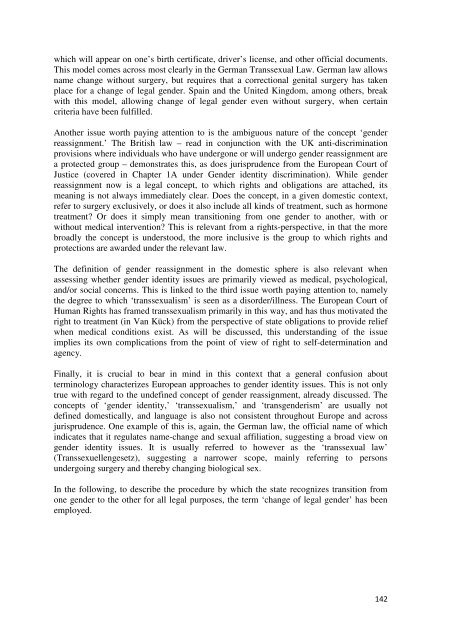Johanna Westeson - The ICHRP
Johanna Westeson - The ICHRP
Johanna Westeson - The ICHRP
Create successful ePaper yourself
Turn your PDF publications into a flip-book with our unique Google optimized e-Paper software.
which will appear on one’s birth certificate, driver’s license, and other official documents.<br />
This model comes across most clearly in the German Transsexual Law. German law allows<br />
name change without surgery, but requires that a correctional genital surgery has taken<br />
place for a change of legal gender. Spain and the United Kingdom, among others, break<br />
with this model, allowing change of legal gender even without surgery, when certain<br />
criteria have been fulfilled.<br />
Another issue worth paying attention to is the ambiguous nature of the concept ‘gender<br />
reassignment.’ <strong>The</strong> British law – read in conjunction with the UK anti-discrimination<br />
provisions where individuals who have undergone or will undergo gender reassignment are<br />
a protected group – demonstrates this, as does jurisprudence from the European Court of<br />
Justice (covered in Chapter 1A under Gender identity discrimination). While gender<br />
reassignment now is a legal concept, to which rights and obligations are attached, its<br />
meaning is not always immediately clear. Does the concept, in a given domestic context,<br />
refer to surgery exclusively, or does it also include all kinds of treatment, such as hormone<br />
treatment? Or does it simply mean transitioning from one gender to another, with or<br />
without medical intervention? This is relevant from a rights-perspective, in that the more<br />
broadly the concept is understood, the more inclusive is the group to which rights and<br />
protections are awarded under the relevant law.<br />
<strong>The</strong> definition of gender reassignment in the domestic sphere is also relevant when<br />
assessing whether gender identity issues are primarily viewed as medical, psychological,<br />
and/or social concerns. This is linked to the third issue worth paying attention to, namely<br />
the degree to which ‘transsexualism’ is seen as a disorder/illness. <strong>The</strong> European Court of<br />
Human Rights has framed transsexualism primarily in this way, and has thus motivated the<br />
right to treatment (in Van Kück) from the perspective of state obligations to provide relief<br />
when medical conditions exist. As will be discussed, this understanding of the issue<br />
implies its own complications from the point of view of right to self-determination and<br />
agency.<br />
Finally, it is crucial to bear in mind in this context that a general confusion about<br />
terminology characterizes European approaches to gender identity issues. This is not only<br />
true with regard to the undefined concept of gender reassignment, already discussed. <strong>The</strong><br />
concepts of ‘gender identity,’ ‘transsexualism,’ and ‘transgenderism’ are usually not<br />
defined domestically, and language is also not consistent throughout Europe and across<br />
jurisprudence. One example of this is, again, the German law, the official name of which<br />
indicates that it regulates name-change and sexual affiliation, suggesting a broad view on<br />
gender identity issues. It is usually referred to however as the ‘transsexual law’<br />
(Transsexuellengesetz), suggesting a narrower scope, mainly referring to persons<br />
undergoing surgery and thereby changing biological sex.<br />
In the following, to describe the procedure by which the state recognizes transition from<br />
one gender to the other for all legal purposes, the term ‘change of legal gender’ has been<br />
employed.<br />
142
















